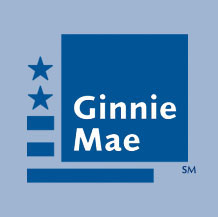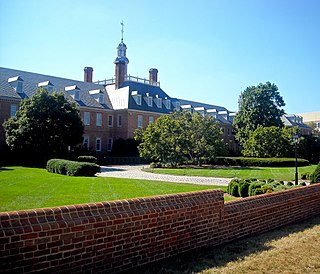Related Research Articles

The Government National Mortgage Association (GNMA), or Ginnie Mae, is a government-owned corporation of the United States Federal Government within the Department of Housing and Urban Development (HUD). It was founded in 1968 and works to expand affordable housing by guaranteeing housing loans (mortgages) thereby lowering financing costs such as interest rates for those loans. It does that through guaranteeing to investors the on-time payment of mortgage-backed securities (MBS) even if the underlining mortgages go into default and the homes are foreclosed upon.

The Federal National Mortgage Association (FNMA), commonly known as Fannie Mae, is a United States government-sponsored enterprise (GSE) and, since 1968, a publicly traded company. Founded in 1938 during the Great Depression as part of the New Deal, the corporation's purpose is to expand the secondary mortgage market by securitizing mortgage loans in the form of mortgage-backed securities (MBS), allowing lenders to reinvest their assets into more lending and in effect increasing the number of lenders in the mortgage market by reducing the reliance on locally based savings and loan associations. Its brother organization is the Federal Home Loan Mortgage Corporation (FHLMC), better known as Freddie Mac. As of 2018, Fannie Mae is ranked number 21 on the Fortune 500 rankings of the largest United States corporations by total revenue.

The Federal Home Loan Mortgage Corporation (FHLMC), known as Freddie Mac, is a public government-sponsored enterprise (GSE), headquartered in Tysons Corner, Virginia. Freddie Mac is ranked No. 38 on the 2018 Fortune 500 list of the largest United States corporations by total revenue.

A mortgage-backed security (MBS) is a type of asset-backed security which is secured by a mortgage or collection of mortgages. The mortgages are aggregated and sold to a group of individuals that securitizes, or packages, the loans together into a security that investors can buy. Bonds securitizing mortgages are usually treated as a separate class, termed residential; another class is commercial, depending on whether the underlying asset is mortgages owned by borrowers or assets for commercial purposes ranging from office space to multi-dwelling buildings.
A government-sponsored enterprise (GSE) is a type of financial services corporation created by the United States Congress. Their intended function is to enhance the flow of credit to targeted sectors of the economy, to make those segments of the capital market more efficient and transparent, and to reduce the risk to investors and other suppliers of capital. The desired effect of the GSEs is to enhance the availability and reduce the cost of credit to the targeted borrowing sectors primarily by reducing the risk of capital losses to investors: agriculture, home finance and education. Well known GSEs are the Federal National Mortgage Association, or Fannie Mae, and the Federal Home Loan Mortgage Corporation, or Freddie Mac.
In the United States, a conforming loan is a mortgage loan that conforms to GSE guidelines. The most well-known guideline is the size of the loan, which, for 2019, was generally limited to $484,350 for single family homes in the continental US. Other guidelines include borrower's loan-to-value ratio, debt-to-income ratio, credit score and history, documentation requirements, etc.
In the United States, a jumbo mortgage is a mortgage loan that may have high credit quality, but is in an amount above conventional conforming loan limits. This standard is set by the two government-sponsored enterprises, Fannie Mae and Freddie Mac, and sets the limit on the maximum value of any individual mortgage they will purchase from a lender. Fannie Mae (FNMA) and Freddie Mac (FHLMC) are large agencies that purchase the bulk of U.S. residential mortgages from banks and other lenders, allowing them to free up liquidity to lend more mortgages. When FNMA and FHLMC limits don't cover the full loan amount, the loan is referred to as a "jumbo mortgage". Traditionally, the interest rates on jumbo mortgages are higher than for conforming mortgages, however with GSE fees increasing, Jumbo loans have recently seen lower interest rates than conforming loans.

A mortgage loan or simply mortgage is a loan used either by purchasers of real property to raise funds to buy real estate, or alternatively by existing property owners to raise funds for any purpose while putting a lien on the property being mortgaged. The loan is "secured" on the borrower's property through a process known as mortgage origination. This means that a legal mechanism is put into place which allows the lender to take possession and sell the secured property to pay off the loan in the event the borrower defaults on the loan or otherwise fails to abide by its terms. The word mortgage is derived from a Law French term used in Britain in the Middle Ages meaning "death pledge" and refers to the pledge ending (dying) when either the obligation is fulfilled or the property is taken through foreclosure. A mortgage can also be described as "a borrower giving consideration in the form of a collateral for a benefit (loan)".
In finance, subprime lending is the provision of loans to people who may have difficulty maintaining the repayment schedule. Historically, subprime borrowers were defined as having FICO scores below 600, although this threshold has varied over time.
A Super jumbo mortgage is classified in the United States as a residential mortgage or other home-equity secured loan in an amount greater than $650,000, although lenders differ on just what constitutes a super jumbo mortgage subject to their own internal investment criteria. Super Jumbo mortgages are made available to borrowers whose loan requirements exceed the guidelines commonly referred to as Jumbo loan limits, which apply to mortgage loan amounts in excess of the FNMA / FHLMC conforming loan limits of 417,000. Unlike Jumbo loan limits, the super jumbo mortgage category is not directly defined, controlled, or regulated by any of these aforementioned agencies. Instead, mortgage lenders internally and independently define their own parameters and criteria for what defines a Super Jumbo mortgage. The minimum loan amount for some lenders to classify a loan as Super Jumbo ranges from $500,000 to $1,500,000, with maximum super jumbo loan amounts generally running into the $10,000,000 to $20,000,000 range.
An Alt-A mortgage, short for Alternative A-paper, is a type of U.S. mortgage that, for various reasons, is considered riskier than A-paper, or "prime", and less risky than "subprime," the riskiest category. For these reasons, as well as in some cases their size, Alt-A loans are not eligible for purchase by Fannie Mae or Freddie Mac. Alt-A interest rates, which are determined by credit risk, therefore tend to be between those of prime and subprime home loans, although there is no single accepted definition of Alt-A. Typically Alt-A mortgages are characterized by borrowers with less than full documentation, average credit scores, higher loan-to-values, and more investment properties and secondary homes. A-minus is related to Alt-A, with some lenders categorizing them the same, but A-minus is traditionally defined as mortgage borrowers with a FICO score of below 680 while Alt-A is traditionally defined as loans lacking full documentation. Alt-A mortgages may have excellent credit but may not meet underwriting criteria for other reasons. During the past decade, a significant amount of Alt-A mortgages resulted from refinancings, rather than property purchases.
The subprime mortgage crisis impact timeline lists dates relevant to the creation of a United States housing bubble and the 2005 housing bubble burst and the subprime mortgage crisis which developed during 2007 and 2008. It includes United States enactment of government laws and regulations, as well as public and private actions which affected the housing industry and related banking and investment activity. It also notes details of important incidents in the United States, such as bankruptcies and takeovers, and information and statistics about relevant trends. For more information on reverberations of this crisis throughout the global financial system see Financial crisis of 2007–2008.
The Housing and Economic Recovery Act of 2008 was designed primarily to address the subprime mortgage crisis. It authorized the Federal Housing Administration to guarantee up to $300 billion in new 30-year fixed rate mortgages for subprime borrowers if lenders wrote down principal loan balances to 90 percent of current appraisal value. It was intended to restore confidence in Fannie Mae and Freddie Mac by strengthening regulations and injecting capital into the two large U.S. suppliers of mortgage funding. States are authorized to refinance subprime loans using mortgage revenue bonds. Enactment of the Act led to the government conservatorship of Fannie Mae and Freddie Mac.

The Federal Housing Finance Agency (FHFA) is an independent federal agency in the United States created as the successor regulatory agency of the Federal Housing Finance Board (FHFB), the Office of Federal Housing Enterprise Oversight (OFHEO), and the U.S. Department of Housing and Urban Development government-sponsored enterprise mission team, absorbing the powers and regulatory authority of both entities, with expanded legal and regulatory authority, including the ability to place government sponsored enterprises (GSEs) into receivership or conservatorship.

The federal takeover of Fannie Mae and Freddie Mac was the placing into conservatorship of the government-sponsored enterprises (GSEs) Federal National Mortgage Association and Federal Home Loan Mortgage Corporation by the U.S. Treasury in September 2008. It was one of the financial events among many in the subprime mortgage crisis.
The U.S. subprime mortgage crisis was a set of events and conditions that led to a financial crisis and subsequent recession that began in 2007. It was characterized by a rise in subprime mortgage delinquencies and foreclosures, and the resulting decline of securities backed by said mortgages. Several major financial institutions collapsed in September 2008, with significant disruption in the flow of credit to businesses and consumers and the onset of a severe global recession.
Delta Funding Corporation was a specialty consumer finance company that originated, securitized and sold non-conforming mortgage loans.

The mortgage industry of the United States is a major financial sector. The federal government created several programs, or government sponsored entities, to foster mortgage lending, construction and encourage home ownership. These programs include the Government National Mortgage Association, the Federal National Mortgage Association and the Federal Home Loan Mortgage Corporation.
The Home Affordable Refinance Program (HARP) is a federal program of the United States, set up by the Federal Housing Finance Agency in March 2009, to help underwater and near-underwater homeowners refinance their mortgages. Unlike the Home Affordable Modification Program (HAMP), which assists homeowners who are in danger of foreclosure, this program benefits homeowners whose mortgage payments are current, but who cannot refinance due to dropping home prices in the wake of the U.S. housing market correction.
This is an unannotated bibliography of writings about Fannie Mae and Freddie Mac as well as some material that covers other government sponsored enterprises such as the Federal Home Loan Bank System. While it is comprehensive, it is not exhaustive, with a focus on work published through 2011 by government agencies, economists, legal and policy scholars, private sector analysts and think tanks. It does not include Congressional testimony and shorter works. This bibliography has been posted on Wikipedia so that others can make additions to it. The original document may be found on SSRN. Please continue to follow guidelines consistent with the Chicago Manual of Style when editing this bibliography.
References
- ↑ "Archived copy" (PDF). Archived from the original (PDF) on 2008-07-24. Retrieved 2008-05-22.CS1 maint: archived copy as title (link)